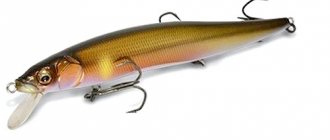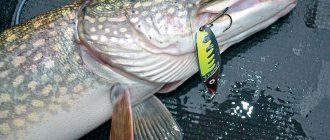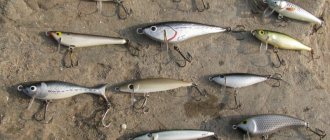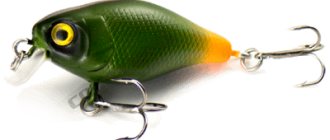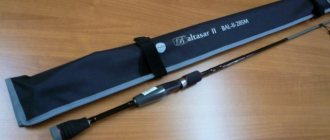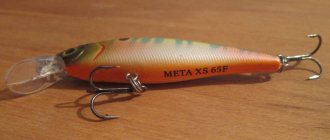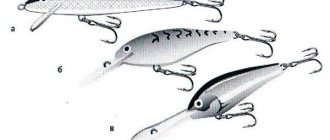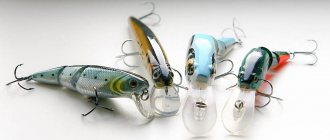Wobblers for twitching
In 2014, I became seriously interested in fishing with wobblers; I devoted about half of the fishing trips of the 2014 season to them. And I have my own “favorites” that I want to tell you about.
I would also like to note that I began to master fishing with wobblers when I switched to fishing with multiplier gear. And this is not just so, it is when fishing with a multi that the angler has a number of advantages when working with this type of bait, especially when using jerking (twitching).
And so here is my “unstoppable seven”.
Jackall Tiny Magallon SP\SR. (8.8 cm, 7.2 g)
This wobbler doesn’t need much introduction. He has long won the hearts of many fishermen and my heart was no exception. In common people it is better known as “tinik”. In the 2014 season, the Jackall Tiny Magallon became my favorite wobbler. More pike of various sizes have been caught with it, and medium-sized perch are also often caught with tinik.
A special feature of the wiring is a long pause; it is this that provokes the most passive predator to attack. Most often, I used this wobbler in shallow water areas, near reed thickets, at medium distances, since the wobbler is an articulated wobbler, and casting range for the wobblers is not their strong point. When purchasing the Jackall Tiny Magallon, I had high hopes for this wobbler and they were justified to an even greater extent.

Pike caught on a Jackall Tiny Magallon wobbler
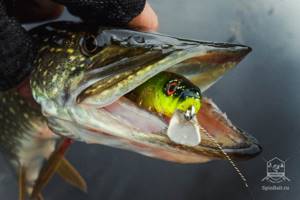
Jackall Tiny Magallon
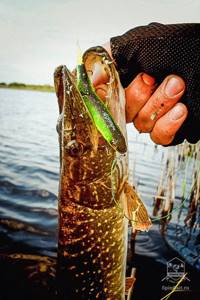
Jackall Tiny Magallon beaten by pike attacks
What is twitching in fishing?
Twitching means a special type of fishing technique in which a certain cycle of jerking and stopping wobblers of various modifications is performed. Depending on the design features of the bait, movements with the rod are performed with different strength and amplitude. The duration of pauses with this fishing method will depend on the model of the wobbler, the specific fishing conditions, as well as the degree of activity of the potential prey.
Catching predators by twitching is equally effective in reservoirs with calm water and with currents. This is a universal way of hunting predatory fish, regardless of where it is located: at depth, at a certain point in the reservoir. The jerking technique is well suited for actively searching for fish. Thanks to the “live” action of the bait, it is possible to attract the attention of both a passive predator and one in search of food.
The twitching method of fishing is especially relevant for catching a toothy beast - pike. The market offers a huge range of jerking wobblers for different fishing conditions, which gives the angler the opportunity to choose a catchy option for a specific body of water. Not only pike, but also perch show interest in the chaotic movements of an attractive bait.

This technique is not as simple as it seems at first glance; in order to provoke a predator to grab the bait, you will need some experience, properly equipped gear and knowledge of everything that happens under water: how the bait behaves, when you need to stop, at what point to hook.
Among the positive characteristics of twitching wiring, experienced fishermen note:
- wide scope of application;
- all-season;
- high performance indicators;
- variety of baits;
- activity of the fishing process.
To briefly describe twitching, it is a fishing method for promising fishermen who know how to calculate the moves of a predator and beat it.
Zip Baits Orbit 80 SP\SR. (8 cm., 8.5 g.)
Orbit is an excellent wobbler-searcher for active pike. Excellent for high-speed fishing of large water areas.
It is distinguished by accuracy and casting range, and this is the merit of the patented Zip Baits - Mag-Drive system.
It often helps out in situations where you need an accurate cast to the place where the pike “splash”. Orbit works just as well on passive fish, you just need to slow down the retrieve.
There is also a deep-sea model Zip Baits Orbit 80 SP\DR in use, but it was not possible to achieve much success with it. I consider this wobbler number one in water bodies with a depth of up to 2-2.5 meters for small and medium-sized pike. The Orbit 80 somehow didn’t work out well with perch; I didn’t catch a single one throughout the entire season.

Even such a pike does not miss Zip Baits Orbit
Megabass Vision 95
This is perhaps the most famous wobbler for jerk animation. The main requirement for him is pauses. After a jerk, the wobbler does not stop immediately, but makes several oscillations in the vertical plane and after that it freezes. That is, it is important to give this pause and then make another breakthrough. The intensity of the jerks may vary, but for this wobbler, smooth pulls with a slow start are best suited. This wobbler also has a budget analogue - Kosadaka Mystic 95. However, the copy is floating and is not entirely suitable for long pauses.
Smith Jib 90 F. (9 cm, 6.7 g)
King of shallow waters in distant areas. A wonderful wobbler with an unusual body geometry. A distinctive feature is its rapid ascent to the surface of the water, which introduces a number of features into its wiring.
It is thanks to its “active” ascent that the Smith Jib 90 F can be carried out in the shallowest areas of reservoirs. And it is the full ascent of the wobbler to the surface that often provokes the predator to attack.
This wobbler is perfect for high-speed fishing in shallow water areas.
Excellent casting range is another important advantage of the Jib. When I first used Jib, I was surprised by one of its features - active native play. It would seem, how can a wobbler with such a small blade have its own pronounced game? But no, she is. Therefore, it can be driven by stop&go wiring, but I prefer twitching.
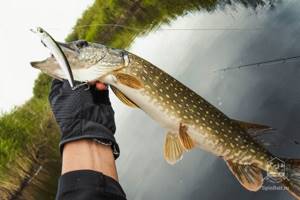
Pike caught on Smith Jib
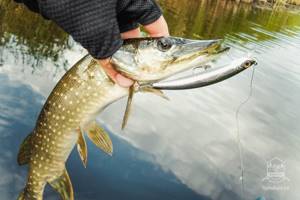
Smith Jib
Jackall Squad Minnow 65. (6.5 cm, 5.8 g)
The smallest representative from the Squad Minnow series from Jackall. A “well-fed” mina with a pronounced personal game. Quite stubborn for its size.
When retrieving, he loves short jerks, a series of such short jerks, as well as pumping pulls. Not large pike, but also perch respond well to the Squad Minnow 65.
Perhaps when fishing for perch, the coloring of the model I had - “perch-like” - played a role here, although this is just a guess.
The Squad Minnow often saved lives in conditions where the fish refused to take larger baits, namely, it was actively attacked.

Alexey and his trophy, taken on Jackall Squad Minnow 65

Pike on Jackall Squad Minnow
Top 10 wobblers for perch
Let's look at the best wobblers for perch.
YO – ZURI L – Minnow 44
YO – ZURI L – Minnow 44 – length – 44 mm, weight – 5 g. The weight is formed thanks to the built-in load. This ensures long casts, which contributes to successful fishing. Buoyancy – sinking. Fishermen often use this bait. It can be used by beginning anglers. They can be used for fishing both in a small river and in a huge reservoir. The bait is used when fishing in the current. It can be driven both along the stream and across it.
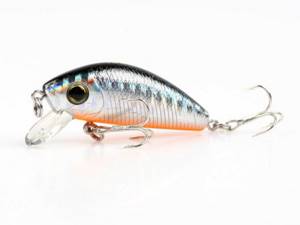
Made of high strength plastic, which protects the wobbler from collisions with underwater obstacles. However, even those specimens that have lost the covering layer are capable of catching fish with no less efficiency. Colors: Golden-black, with a red head and silver body.
Jackall Chuby 38
The material in Jackall Chuby 38 is plastic. Weight 4 g. Available in 38 color options. The paint is durable and remains intact even after long-term use. Size 38 mm. Fat body proportions. It has a pot-bellied shape when viewed from all sides, clearly defined sides, a hump on the back and an elongated tail. The blade is at an angle of 45 degrees to the bait itself. There is a ring at the junction of the blade and the body of the bait. Inside the case there are 4 small metal balls.
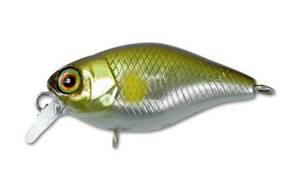
Two of them are motionless and attached near the pelvic fin, the other two are mobile and are located in the free blade. The purpose of the balls is to create a dull sound when wiring. Thanks to these balls, the wobbler is highly effective when used in muddy water.
Jackall Tiny Fry 38
Jackall Tiny Fry 38 belongs to the Minou type bait and is a universal device. Length – 38 mm, weight – 1.5 g. The appearance of the wobbler is very similar to the fry. This look looks real. The body is covered with scales and lateral lines. The hooks are strong and will last more than one season.
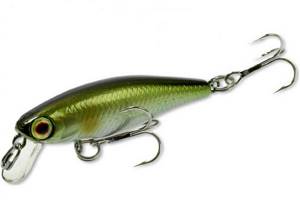
The long-distance casting system and thin cord allow you to cast the bait far enough. The wobbler plays steadily with any retrieve and current. It follows the natural movements of a small fish, which makes it desirable to a predator.
Pontoon 21 Cheerful
Pontoon 21 Cheerful - length 34-60 mm, weight 2.5 g. It looks like a small fish with hooks. The body is slightly flattened laterally, the body is long. This shape imitates white fish fry. Balancing system inside the wobbler: three movable tungsten balls. Thanks to them, the bait is stable in flight and the bait splashes down correctly.

The sound of the balls also attracts fish. Despite its small size, this wobbler does not overlap when casting. A wide selection of colors allows you to choose the bait that will be most suitable for given fishing conditions.
ZipBaits Khamsin 70 SP
ZipBaits Khamsin 70 SP allows you to fish at a depth of 2-2.5 m. It has a classic shad shape: a high back and a narrowing rear part. The design imitates a large fry. Length 70 mm, weight – 9.5 g. It has a long and narrow blade, which is located at an angle of 45 degrees.

After the wobbler is lowered into the water, it takes up a working position. Does not work well in shallow water (depth up to 0.5 m). It has good cross-country ability: its shape allows it to pass through dense thickets. When fishing for perch, it is important to make a long cast of 20-25 m. There is a cylindrical weight in the central part. When a cast occurs, the load moves to the tail; after landing, the load returns to its original position thanks to the magnet.
ZipBaits Orbit 80
ZipBaits Orbit 80 is a Minnow type. It has the shape of an “Orbit” body. It copies a narrow-bodied fish. The bait can be thickly coated, or it can be made of plastic, through which the insides are visible. There is no noise system.

Length 80 mm, weight – 3.5 g. Buoyancy “Suspender”, which means that it hangs in the water column. It has a long, purlined body, round in cross-section. A balancing system with a tungsten weight is built inside. There is a barrel-shaped weight built into the head. With uneven wiring, the wobbler bites with its nose and resembles a fry that is feeding.
{banner_vnutri-kontenta-3}
Pontoon 21 Crack Jack
Pontoon 21 Crack Jack weighs up to 2.5 g, length – 80 cm. The model has neutral buoyancy. Moves smoothly. If necessary, he is active. Equipped with a balancing system consisting of magnets. Thanks to this, the bait was able to fly far when casting and stay at an average depth.

The bait is equipped with two strong hooks. The tees have high-quality grooves that are designed for moving fish. Numerous attempts to get the fish off the hook end in failure. This is due to the fact that durable metal that is resistant to corrosion was used in manufacturing.
Kosadaka Cord-R 70 F
The length of Kosadaka Cord-R 70 F is 70-110 mm, weight is 4.15 g. It has a protruded body that corresponds to the classic Minnow. The advantage of this model is that it is made in the form of a double joint. The components are attached to each other with special loops. This ensures the action of the bait, the movements of which in the water imitate a small fry.

The model has a bright silicone tail. This encourages additional play in the water. It is better to store this bait in a separate box, since the silicone can melt in the heat. There are good flight qualities, thanks to the triple ball.
Strike Pro Midge
Strike Pro Midge is 40mm long. Weight 3 g. Small bait belonging to the minnow species. The body is elongated. Carries out a game, which is also accompanied by noise. It is created by a sound chamber inside the bait.
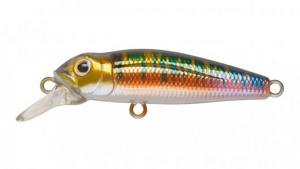
From a distance the bait looks like an insect. Thanks to the sound effect, the fish perceives the wobbler as a living creature that has fallen from the shore into the water. Biting is possible even at the moment of splashdown. Places where this bait can be used: narrow rivers, lakes and shallow reservoirs. Made of impact-resistant plastic, which will maintain the shape of the fish in case of unsuccessful casting.
Megabass FX9. (9 cm., 10.5 g.)
One of the few representatives of Megabass wobblers in my collection. I purchased this wobbler in the fall. It would seem that the pike had already begun to move to deeper parts of the reservoir, but despite this, the FX 9 did an excellent job of collecting the last pike in the shallows.
One of the features is a folding blade, which, when casting under air resistance, is pressed against the body of the bait, which has a good effect on the casting distance.
In its play, the wobbler is similar to the Smith Jib 90 F, but has a lower ascent speed and a more sweeping twitching game. Another feature is the wobbler tees - they are quite powerful and have an “external sting”, so when fishing, the number of trips is minimal. It will be possible to fully open the wobbler only in the 2015 season, but there are already some positive impressions left.

Autumn pike caught on Megabass FX9

Zip Baits Rigge 70 F\SR. (7 cm., 4.7 g.)
I bought this wobbler thanks to many flattering reviews about it and did not regret it. Rigge has proven itself well when fishing for pike in hot weather, when you need a compact bait in shallow water. Both pike and perch responded well to it.
Just like the Zip Baits Orbit, the Mag-drive long-distance casting system is used here, therefore, there are no problems with accuracy and range. When wiring, I most often used single jerks, during which the wobbler made turns. I also most often use the Rigge 70 in “perch boilers”, I don’t know why, but its performance in the “boiler” is higher than with other wobblers.

Twitching is not only for minnows
Indeed, at first only “non-playing” models were twitched, because such animation suggested itself and no questions arose.
And playing wobblers attract fish quite well even with a steady retrieve, so there was no need to think about twitching with them. But over time, it became clear that all wobblers and not only them can be twitched. So, the first step from the classics was jerking shads . And it gave excellent results. The only thing is that jerks with them should be short and quite sharp.
fats came into play . True, these were mostly shallow-water versions, but still jerking thick short wobblers gave excellent results for perch.
Jerk retrieval of large wobblers-minnows and deep-sea minou
With the first ones everything is quite simple. The set of gear does not have certain features: a fast or ultra-fast spinning action and a reel with good laying. Only the test should be higher than for a 95-115 mm minnow. Thus, wobblers measuring 130-150 mm weigh approximately from 16 to 32 grams. It is clear that among the smaller ones there are heavyweights, but do not forget about frontal resistance: the larger the wobbler, the greater the resistance. The only exception is the jerk minnows of the marine pencil geometry series. Among them there are models up to 250 mm long, but they weigh the same as the smaller ones. However, due to their “slenderness,” they offer virtually no resistance in water.
The jerking of large wobblers looks the same as the wiring of smaller wobblers. That is, the jerk length will be approximately the same in the case of the 90 mm and 130 mm models. Only for the latter you need to pull a little harder to move it, giving a large initial acceleration.
At first glance, deep-water wobblers differ from shallow-water wobblers in that they have a blade and slightly greater resistance for the same size. But in practice they behave somewhat differently. Therefore, there are two nuances that should be taken into account before jerking deep-sea wobblers.
- A twitching rod should have a soft tip. At first glance, this contradicts the “laws” of jerk wiring, but here’s the thing. If you twitch a deep wobbler with a regular hard fishing rod, it will stray from the horizon and go significantly higher than its working level. In addition, only a soft tip will help you understand all the nuances of the deep’s behavior under water during wiring.
- After casting, it is necessary to make from three to ten revolutions of the reel at an average pace so that the wobbler reaches the specified depth and after that begin retrieving.
- The more aggressive the jerks, the closer to the surface the deep goes. But this feature sometimes helps. For example, in the case when a splash of pike was noticed at a casting distance in a shallow area. In order not to waste time replacing the bait, we simply throw the dip there. But in this case, the jerk drive must begin immediately after splashdown, and the drive must be aggressive. In this case, the rod tip should be kept higher. Thus, a deep-sea wobbler can be carried quite safely at a meter depth.
Video from an article about different types of wobbler wiring:
Despite the external similarity of minnow wobblers, the behavioral nuances of each of them are different. Therefore, it is worth paying more attention to the choice of jerk strength, amplitude and pause time. Thus, by constantly experimenting with a wobbler, you can understand all the features of its behavior and use them for your own purposes. And in this case, an unspoken rule applies: the closer to Japan the wobbler is made, the more detailed you need to approach its study. In practice, this means that it is not always possible to catch an expensive bait and only over time does it begin to work at full capacity. In this case, it would be a good idea to start mastering jerking with wobblers of inexpensive brands, since budget baits are easy to learn and master. And only then move on to more expensive models.
Pontoon 21 Greedy Guts 77 F\SR (7.7 cm, 9 gr.)
This is one of the last wobblers from Pontoon 21, which I decided to keep in my arsenal. Works well on active medium pike and medium/large perch. Most often I used wiring alternating a series of jerks with a pause. The ascent speed of the wobbler is low, which is something not many floating wobblers with a depth of up to 1-1.2 meters have.
When the wobbler begins to slowly rise in the water column, bites often occur. The wobbler has a good casting range, thanks to its light weight for its size.
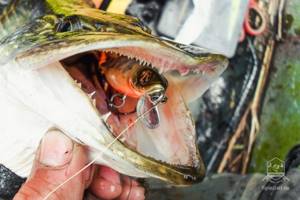
Pontoon 21 Greedy Guts 77 in the mouth of a pike
In this article, I tried to most widely reveal the features and wiring of my favorite wobblers for twitching for the spring-autumn season of 2014. You shouldn’t get hung up on one bait and wiring, constantly experiment and you will be happy.
If you have any questions about the kit, or to me personally, please leave them in the comments to the article.
Author: Alexey Spirin (Specially for SpinBait.ru)
Twitching: fishing technique for pike
Starting twitch wiring is performed as follows:
- 2 sharp jerks are made with the spinning rod, at the same time reeling in the fishing line;
- now you need to wait a little;
- and do 2 more jerks.
This starting wiring option is relevant for starting fishing when there is still no information about the mood of the fish. The reel can be rotated at this time with pauses or evenly, but the line should always remain taut.
In addition to the standard version, it is also necessary to use other methods of wiring, combining different styles, short and long jerks with different pause times. You can try the following options:
- 2 long jerks, then 1 short, then 1 long and after a pause, repeat;
- pause after 1 long jerk;
- pause after 3 long jerks;
- 2 long jerks, then one gentle one and a pause, etc.
Fishing for pike using this method is an individual and creative process that must be constantly improved and changed to select the most effective option. Only in this case can success be achieved.
Video: Twitching technique. Popular beginner mistakes
The video talks about the most common mistakes of spinning players who are just starting their acquaintance with twitching. What is correct twitching?
In the event that several proven twitching wiring along with changing the wobbler did not give the desired effect, you can try changing the bait to another or try uniform wiring. Sometimes the pike may refuse to respond to jerking movements, but often twitching leads to its fruits, so it is imperative to master this technique and have the necessary working wobblers in your kit.
Views: 328
Similar articles:
- Top wobblers for pike. The best wobblers for pike fishing 2019-2020 A wobbler is a solid bait for fishing with a spinning rod or...
- Trolling pike. TOP 10 best wobblers for trolling for pike Pike, especially large ones, most often stay at depth, and to catch…
- Catching pike with a wobbler Pike is a voracious river predator, which can be fished all year round...
- Catching pike with wobblers in spring. Top 10 best spring wobblers Spring is a great time for fishing, especially for such a toothy...


